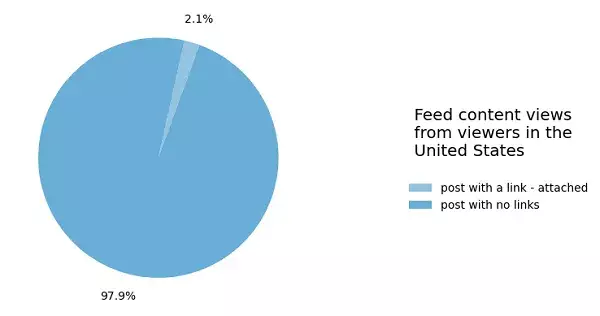Meta’s recent comprehensive overview sheds light on various pressing issues pertaining to content engagement, violations, and hacking attempts on its platforms. As we delve deeper into the statistics and trends observed for the fourth quarter of 2024, it becomes clear that the landscape of social media is ever-evolving, and Meta is at the center of this transformative period.
One of the most striking revelations in Meta’s latest report is the declining proportion of posts containing external links. In Q4 2024, a staggering 97.9% of views on U.S. Facebook posts did not lead to content outside of the platform. This marks a significant increase from 86.5% just over three years ago, indicating a trend that is not only alarming for content publishers but also for users seeking diverse information sources.
The implications of this trend suggest a tightening grip of the platform on its users’ engagement, effectively funneling them into an echo chamber of content that lacks external viewpoints. As Meta appears to shift focus away from news and towards more controlled types of engagement, the ability for content creators to drive traffic via organic reach diminishes substantially. For many businesses and creators relying on Facebook for audience growth, this presents a bleak outlook on how social media can serve as a viable channel for increasing visibility.
When assessing the nature of the content that does receive engagement within the platform’s ecosystem, the findings are telling. The most viewed posts again highlighted the superficial nature of social media interactions, frequently dominated by celebrity antics and heartwarming tales that, while endearing, do little to contribute meaningfully to broader discussions.
Examples include holiday-themed content featuring celebrities such as Mark Wahlberg and Neil Patrick Harris, which echoes a trend that prioritizes entertainment value over informational depth. This “tabloidification” of content is not just indicative of what resonates with users but also raises questions about the platform’s role in shaping societal discourse. The prioritization of feel-good stories over substantive news could lead to a populace that is less informed and engaged in critical issues, further emphasizing the need for a balance in content visibility.
Violations and Enforcement: Changes and Challenges
When it comes to content violations, Meta reported no significant spikes in problematic content over the quarter. However, a notable rise in “Violent & Graphic Content” on Instagram complicates the narrative. The increase follows an adjustment in Meta’s detection technologies, hinting at a possible gap in their capacity to proactively manage harmful content. This state of affairs raises concerns about user safety and the adequacy of platforms to moderate their environments effectively.
Additionally, Meta claims that fake accounts made up approximately 3% of monthly active users in Q4 2024, a decrease from the previously accepted industry standard of 5%. While this may indicate an improvement in their detection mechanisms, the true accuracy of these figures is difficult to ascertain. It calls into question the reliability of Meta’s data reporting, especially when considering the potential inconsistencies in how user engagement and violations are calculated.
Further complicating the discussion is the emergence of foreign influence operations, notably from Russia’s “Doppleganger.” The report indicates a strategic shift in focus, with operations reducing their targeting of U.S. and Ukraine audiences while concentrating on Germany, France, and Israel. This shift suggests an adaptation to geopolitical dynamics and an effort to exploit vulnerabilities in these particular populations.
Such influence operations highlight the continuous battle social media platforms face in safeguarding user trust by managing and mitigating external manipulation. As Meta strives to monitor and report on these activities, users are left to ponder the efficacy of these measures and whether they are truly sufficient to protect against such invasive tactics.
Meta’s Q4 2024 report presents a complex mix of challenges and developments in social media engagement and content management. As link-sharing declines, superficial content reigns, and troubling foreign influences persist, the platform’s trajectory raises critical questions about the future of user engagement and discourse. For content creators, marketers, and users alike, understanding these dynamics is essential in navigating the increasingly intricate landscape of social media. As Meta continues to evolve, the impacts of these trends will reverberate throughout the digital ecosystem, making awareness and adaptability key to success in this environment.

